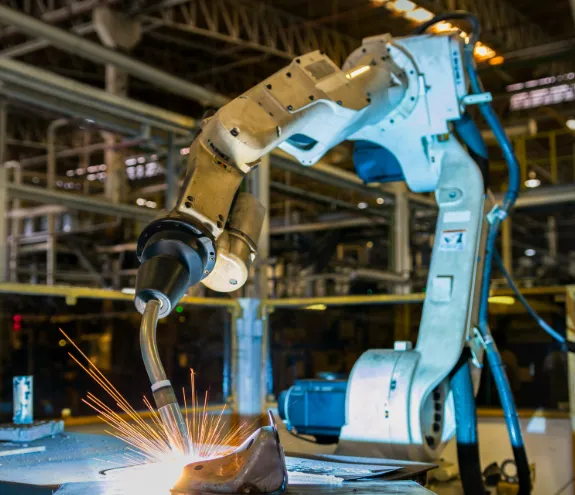When optimizing your robotic welding operations, it’s crucial to focus on every component, including the swanneck. The swanneck plays a significant role in ensuring repeatable, high-quality welds. Understanding its construction, durability, and how it interacts with other elements of the robotic torch can make a big difference in performance and longevity.
What is a Swanneck in Robotic Welding?
A swanneck is a critical part of a robotic welding torch, responsible for maintaining the accuracy and repeatability of the welding process. It’s the section that connects the contact tip to the rest of the robot’s welding arm, guiding the torch in precise movements. To keep your production line running smoothly, it’s essential to understand how the swanneck functions, including its weak points and how it interacts with other components like tip holders, diffusers, and wire liners.
Key Factors Affecting Swanneck Performance
Keying of the Swanneck
The keying system in a robotic welding torch has a significant impact on the swanneck’s durability and performance. There are two types of keyways used in these systems: soft keyways and hard keyways.
- Soft Keyways: Located on the front module of the torch, soft keyways can cause wear and tear over time, leading to a loss of the tool center point (TCP). This results in inaccurate welds and reduced repeatability.
- Hard Keyways: These are designed to minimize rotational movement and prevent excessive wear. Ideally, hard keyways should be incorporated into the torch module itself to maintain long-term performance.
Construction of the Swanneck
The construction of a swanneck is another important consideration when choosing a robotic torch. Swannecks made from a single piece of material are generally more durable than those constructed from multiple components. A solid, one-piece swanneck can maintain the TCP more effectively, reducing the need for constant recalibration. This leads to higher uptime, better throughput, and improved return on investment.
Tip Holders and Diffusers
Tip holders and diffusers are key components that bridge the swanneck and the contact tip. These parts play a role in heat transfer and shielding gas distribution. Some manufacturers combine the tip holder and diffuser into a single unit, offering better conductivity and more efficient shielding gas coverage. However, a single-piece construction might be more prone to bending, which can misalign the contact tip and wire.
Alternatively, separate components for the tip holder and diffuser provide more flexibility and resilience, especially in the event of a collision. The diffuser is designed to perform better during such impacts, helping to maintain the TCP and prevent damage.
Material Choices for Diffusers and Tip Holders
The materials used in constructing tip holders and diffusers can also impact the performance of your robotic welding torch. The most common materials are copper and brass.
- Copper: This soft metal provides excellent conductivity but wears down quickly. It’s commonly used for better heat transfer but requires more frequent replacements.
- Brass: A harder material, brass resists wear better than copper. However, it sacrifices some of the conductivity copper offers. When choosing between the two, consider the balance between durability and conductivity for your application.
Also, pairing the right contact tip material with the diffuser can optimize performance. For example, using a silver-plated contact tip with a brass diffuser provides excellent conductivity, while a copper-zirconium contact tip pairs better with a copper diffuser.
Wire Liners: Neck vs. Front Load
Wire liners are crucial for maintaining smooth wire feeding from the feeder to the contact tip. There are two main types of wire liners: neck liners and front-load liners.
- Neck Liners (Jump Liners): These are cost-effective and easy to install, making them a popular choice. Jump liners run from the torch body to the contact tip, protecting the weakest point of the liner at the torch body. They are quick to replace, minimizing downtime during maintenance.
- Front Load Liners: These liners use mechanical springs for installation, but they can sometimes be unreliable if not properly maintained. While they’re easy to install, they require careful attention to length and correct installation to avoid performance issues.
Choosing the Right Liner Material
Wire liners come in a variety of materials, with steel or metallic designs offering more durability than plastic options. The design of the liner—whether it’s helical or flat—also affects its flexibility. Flat liners are less flexible, which can limit their performance in some setups.
The liner’s diameter is another critical factor. An oversized liner can create excess space around the wire, causing issues like bird nesting or misfeeds. It’s important to match the liner size to the wire diameter to ensure smooth operation and optimal welding results.
Conclusion
To ensure the best performance from your robotic welding system, understanding the components that make up the swanneck is essential. From the construction of the swanneck to the choice of materials for diffusers and wire liners, every detail can impact the quality, repeatability, and longevity of your welding process. By making informed decisions about these elements, you can enhance your productivity, reduce downtime, and maintain high standards for your welded products.







